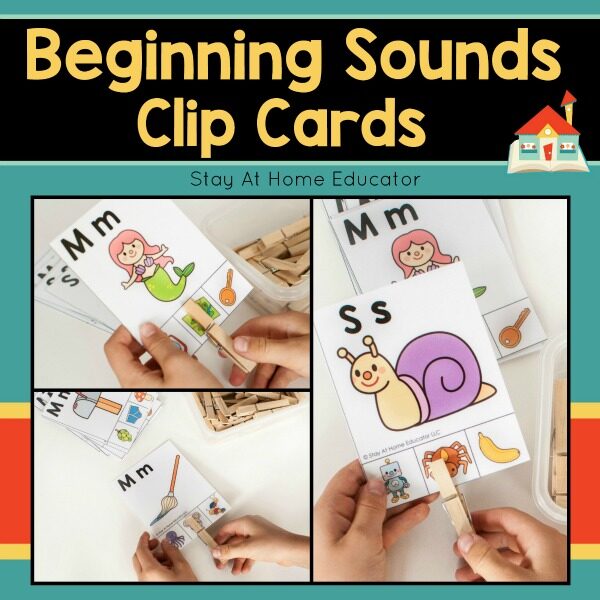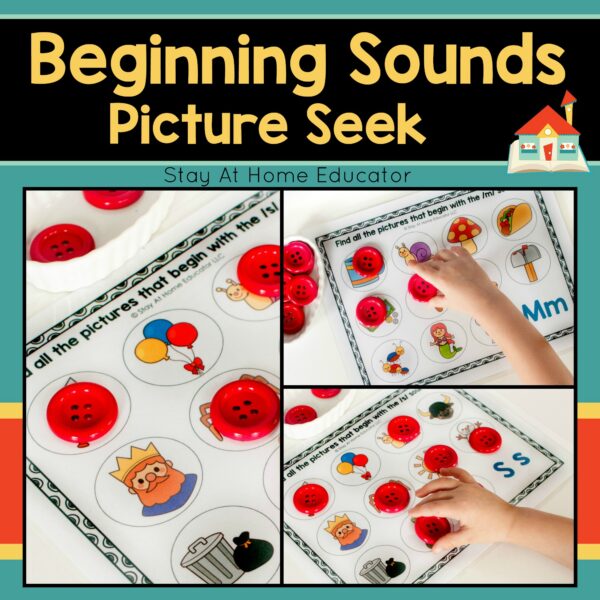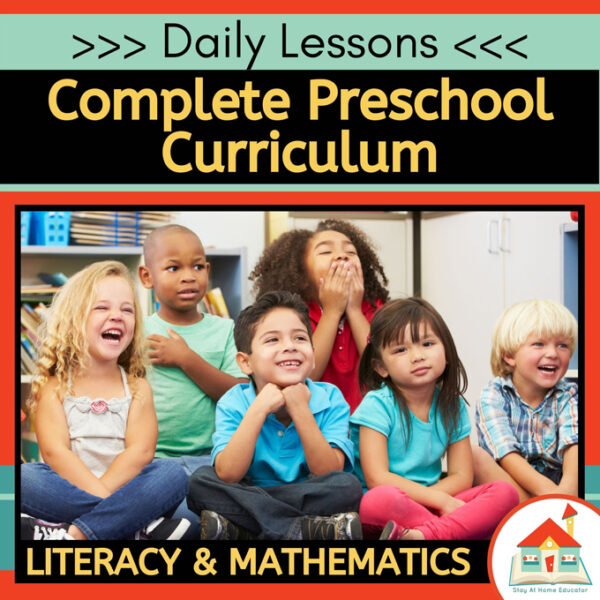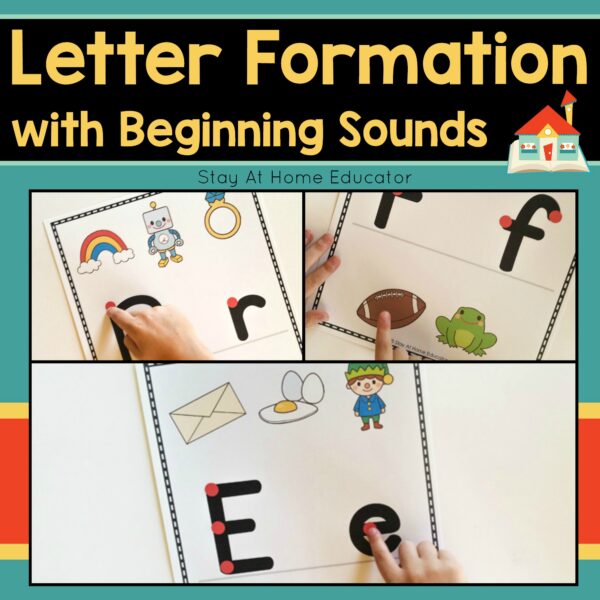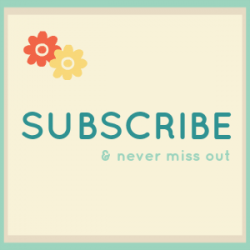Start off the new year with this alphabet pattern blocks printable. They are small task cards that include beginning sounds, too. I’ll show you different ways to use these task cards in your alphabet activities. They offer a fun, hands-on way to practice letter recognition and letter sounds, with an added bonus of fantastic fine-motor skills practice!
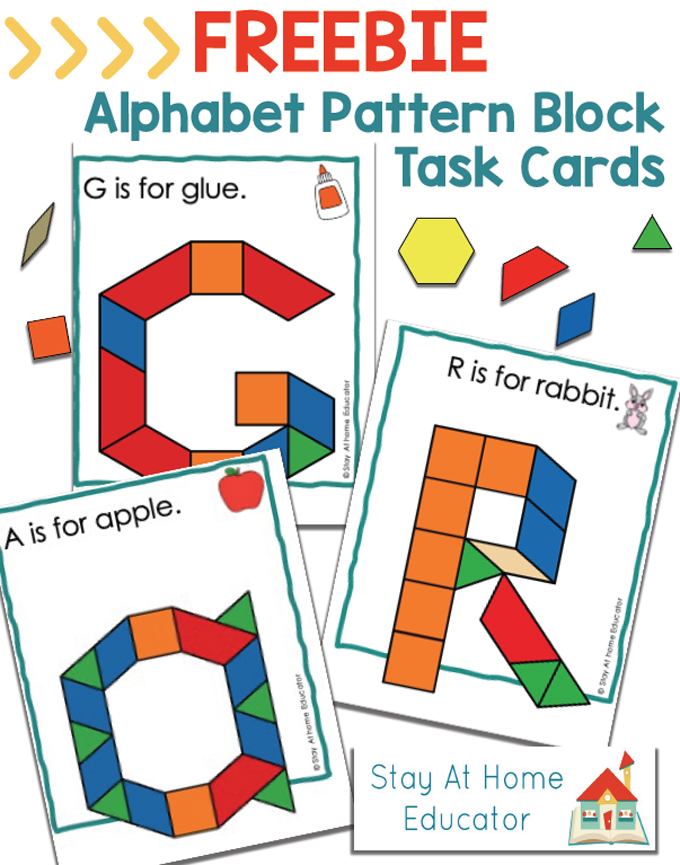
School is nearly back in session, and that means it’s time for some alphabet activities!
One fun way to get your little ones engaged in learning their ABCs is to print out this alphabet pattern blocks printable. The brightly colored blocks are sure to capture their attention, and they’ll have a blast matching the shapes to create letters.
As an added bonus, they’ll also be improving their fine motor skills.
So print out this alphabet pattern blocks printable today and get ready for some fun back-to-school alphabet activities!
Printable Block Letters
Pattern blocks are a versatile educational tool with numerous benefits.
These geometric shapes aid in developing cognitive skills like spatial reasoning and problem-solving as students create patterns and designs.
They also help to understand mathematical concepts such as symmetry, fractions, and geometry in a practical manner.
And of course, pattern blocks promote fine motor skills! Whether in classrooms or at home, pattern blocks offer a practical way to enhance learning and understanding, which is why I can appreciate free printables like this one!
Alphabet Pattern Block Mats
These alphabet pattern blocks printables for preschoolers can also be used as a back to school activity to help your child transition back into the school year. They are a great way to help your child learn their letters while having fun.
As a preschool teacher, I like to use activities like this one to informally assess what my preschoolers already know when they start the school year with me. This gives me a baseline when I use our Preschool Assessments.
Did you know we also have fall pattern block mats and summer pattern block mats?
Materials
- free patterns block alphabet printable
- pattern blocks
How to Set Up This Alphabet Activity
Print the cards on heavy card stock and laminate for added durability. Cut apart the alphabet cards. Put them in a pile on a tray with a set of pattern blocks.
Now invite your preschooler to join you in some alphabet games using the colorful pattern blocks!
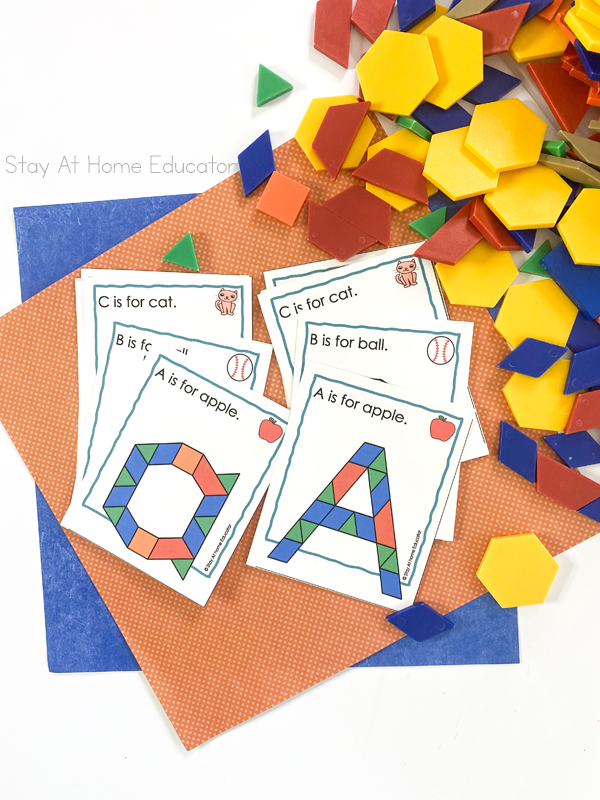
How to Use Pattern Blocks With Preschoolers
These can be used for so many hands on learning activities for kids.
They include all twenty-six letters of of alphabet, in both uppercase letters and lowercase letters, so kids can learn both in preschool and kindergarten.
Invite your preschooler to select a task card. These cards fit four to a page, so they are used to copy the pattern.

I bring these out during the first week of school to see how well preschoolers already know the letters.
I watch as they sift through the pile to find the letters in their name, or other letters they recognize. I observe to see if they make the association between the letter and the picture in the corner; the beginning sound.
Kids love having these in the alphabet center. They pair well with my Daily Lessons in Preschool Literacy Curriculum, and I have actually added them to our weekly letter centers.
Block Letter A
Here is an example of pattern block letter a. The top of the card has a simple sentence that the children can repeat. “A is for apple.” Then, in the upper right corner, there is a picture of an apple, so once the children learn the sentence pattern, they can use the apple picture to read the sentence by themselves.
These are pattern block task cards, so your preschooler can select a card and make the letter right beside it.

Some preschoolers may struggle since they cannot place the pattern block tiles directly over the alphabet mats. To help with this, have your preschooler first identify what colors they see in the patterned letter.
I see two red blocks on the card. Can you find some in the bin? We will need two red blocks to make our letter. See right here?
I continue this until my preschooler has figured out how to collect all the right pattern blocks needed to form the letter. If they collect too many blocks, that’s ok, too. After some practice, your preschooler or kindergarten student will be able to do it without the additional support.

Alphabet Books for Kindergarten
I like to leave these cards in our literacy preschool centers during the first few weeks of school. That, of course means that they can also be used in conjunction with some of our favorite alphabet books for preschool and kindergarten!
Pattern Block Activities
Using pattern blocks with preschoolers can be an effective and enjoyable way to promote early math and cognitive development. Think outside the box and have a little fun with these additional ways to use pattern blocks.
Pattern Block Alphabet
Use these cards to make the entire alphabet. Arrange the cards in alphabetical order, and then invite your preschoolers to help you make the entire alphabet!
Pattern Block Pictures
Offer your preschoolers some picture books or large photographs and encourage them to make their own pattern block pictures. They will learn so much from this kind of free play as they try to figure out which pieces to use to get the desired outcome.
Alphabet Pattern for Kindergarten
These alphabet block pattern cards include both upper case and lower case letters, so invite your older preschoolers or your kindergarten students to match them up and even make patterns!
Activities Using Pattern Blocks
Here are our favorite pattern blocks, then keep reading for even more ideas on how we use them!
Preschool Activities Using Pattern Blocks!
- Summer Pattern Block Mats
- Pattern Block Sensory Bag
- Pattern Block Pictures – Animals
- Pattern Blocks at the Light Table
Get Your Alphabet Pattern Block Here
These task cards can be used for several alphabet activities for preschoolers. They can be used for letter matching activities or seek and find activities. Of course they will do well in your preschool math center and alphabet center.

I’m Sarah, an educator turned stay-at-home-mama of five! I’m the owner and creator of Stay At Home Educator, a website about intentional teaching and purposeful learning in the early childhood years. I’ve taught a range of levels, from preschool to college and a little bit of everything in between. Right now my focus is teaching my children and running a preschool from my home. Credentials include: Bachelors in Art, Masters in Curriculum and Instruction.
